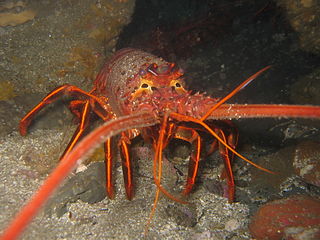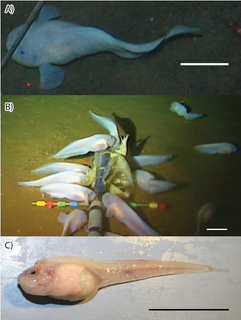
The Liparidae, commonly known as snailfish or sea snails, are a family of scorpaeniform marine fishes.

Lumpsuckers or lumpfish are mostly small scorpaeniform marine fish of the family Cyclopteridae. They are found in the cold waters of the Arctic, North Atlantic, and North Pacific oceans. The greatest number of species are found in the North Pacific.

The California spiny lobster is a species of spiny lobster found in the eastern Pacific Ocean from Monterey Bay, California to the Gulf of Tehuantepec, Mexico. It typically grows to a length of 30 cm (12 in) and is a reddish-brown color with stripes along the legs, and has a pair of enlarged antennae but no claws. The interrupted grooves across the tail are characteristic for the species.

The spiny dogfish, spurdog, mud shark, or piked dogfish is one of the best known species of the Squalidae (dogfish) family of sharks, which is part of the Squaliformes order. While these common names may apply to several species, Squalus acanthias is distinguished by having two spines and lacks an anal fin. It is found mostly in shallow waters and further offshore in most parts of the world, especially in temperate waters. Spiny dogfish in the northern Pacific Ocean have recently been reevaluated and found to constitute a separate species, now known as "Pacific spiny dogfish", Squalus suckleyi.

The paradise fish, paradise-fish, paradisefish, or paradise gourami is a species of gourami found in most types of fresh water in East Asia, ranging from the Korean Peninsula to northern Vietnam. This species can reach a standard length of 6.7 cm (2.6 in), though most are only about 5.5 cm (2.2 in). Paradise gouramis were one of the first ornamental fish available to western aquarium keepers, having been imported 1869 to France by the French aquarium fish importer Pierre Carbonnier in Paris. The paradise fish is one of the more aggressive members of its family. It is more aggressive than the three spot gourami, yet less pugnacious in nature than the less commonly kept combtail.

The spiny softshell turtle is a species of softshell turtle, one of the largest freshwater turtle species in North America. Both the common name, spiny softshell, and the specific name, spinifera (spine-bearing), refer to the spiny, cone-like projections on the leading edge of the carapace, which are not scutes (scales).

Panulirus versicolor is a species of spiny lobster that lives in tropical reefs in the Indo-Pacific. Other names include painted rock lobster, common rock lobster, bamboo lobster, blue lobster, and blue spiny lobster. P. versicolor is one of the three most common varieties of spiny lobster in Sri Lanka, alongside Panulirus homarus and Panulirus ornatus.

Ctenosaura similis, commonly known as the black spiny-tailed iguana, black iguana, or black ctenosaur, is a lizard native to Mexico and Central America that has been introduced to the United States in the state of Florida. It is the largest species in the genus Ctenosaura and has been recorded as the fastest-running species of lizard.
Pseudoliparis amblystomopsis, or the hadal snailfish, is a species of snailfish from the hadal zone of the Northwest Pacific Ocean, including the Kuril–Kamchatka and Japan Trenches.
Notoliparis antonbruuni is a species of snailfish. It was described in 2005 from a single poorly preserved specimen collected in 1966 from the hadal zone off Callao, Peru.

Liparis fabricii, commonly known as the gelatinous seasnail or gelatinous snailfish, is a benthopelagic species of snailfish from the Arctic Ocean. It has a tadpole-like body with a maximum length of about 20 cm (7.9 in). It is brown to black in coloration with a distinctive dark peritoneum. It preys on small crustaceans and marine worms. It is not commercially important, though it is a valuable food source for predatory fish and seabirds in the Arctic region.

Eumicrotremus is a genus of lumpfishes native to the northern oceans. The name for this genus comes from the Greek roots eu meaning "good", mikros meaning "small" or "little", and trema meaning "hole".
Acantholiparis is a genus of snailfishes native to the northern Pacific Ocean.

Macropodus is a genus of small to medium-sized labyrinth fish native to freshwater habitats in eastern Asia. Most species are restricted to southern China and Vietnam, but M. opercularis occurs as far north as the Yangtze basin, and M. ocellatus occurs north to the Amur River, as well as in Japan and Korea. In China, they are often used for fights, so they are named Chinese bettas because of their similarity to the genus Betta. A few species in the genus are regularly seen in the aquarium trade, and M. opercularis has been introduced to regions far outside its native range.
Liparis tunicatus, or the kelp snailfish, is a species of snailfish from the genus Liparis. It can be found in marine, demersal waters at a depth range from 0 to 620 m (0–2,034 ft). The kelp snailfish lives in the Arctic and Northwest Atlantic Ocean among kelp. The species is common, at least around Greenland and Franz Josef Land. A bottom feeder, it eats small crustaceans. At Franz Josef Land, it spawns in March at a depth of 6–25 m (20–82 ft), with the egg clusters attached to kelp.

Liparis callyodon, or the spotted snailfish and by one source the beautiful tooth seasnail, is a fish from the genus Liparis. It lives in marine and demersal environments at a depth range from zero to twenty meters. It can be found at temperate climate zones, such as the eastern Pacific Ocean from Alaska, USA to Oregon, USA, in intertidal zones. The name callyodon comes from the Greek word meaning "beautiful tooth". Pallas chose this name after the species' tricuspid teeth.
Acantholiparis caecus is one of the two snailfishes within the genus Acantholiparis, along with A. opercularis, the spiny snailfish. Its generic name comes from the Greek for thorny (akantha) and fat (liparis); its specific name comes from the Latin word for blind.

The Pacific spiny dogfish is a common species of the Squalidae (dogfish) family of sharks and are among the most abundant species of sharks in the world. This species is closely related to Squalus acanthias and for many years they were treated as a single species. Recent research, using meristic, morphological and molecular data led to the resurrection of Pacific Spiny Dogfish as a separate species. The American Fisheries Society recommends the common name "Pacific Spiny Dogfish" for Squalus suckleyi over alternatives such as "Spotted Spiny Dogfish" and "North Pacific Spiny Dogfish" and "Spiny Dogfish" for Squalus acanthias.

Pseudoliparis swirei, the Mariana snailfish or Mariana hadal snailfish, is a species of snailfish found at hadal depths in the Mariana Trench in the western Pacific Ocean. It is known from a depth range of 6,198–8,076 m (20,335–26,496 ft), including a capture at 7,966 m (26,135 ft), which possibly is the record for a fish caught on the seafloor. Various anatomical, physiological, molecular and genetic adaptions help this species survive in such depths.














